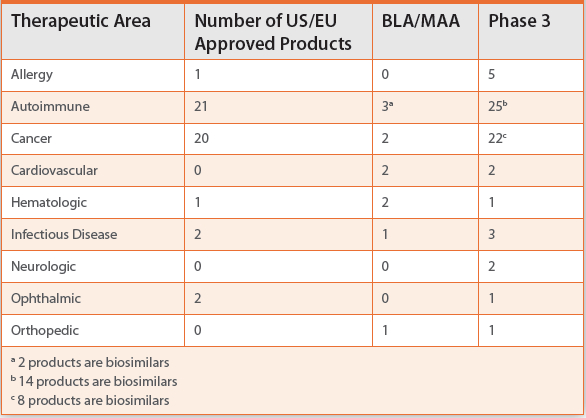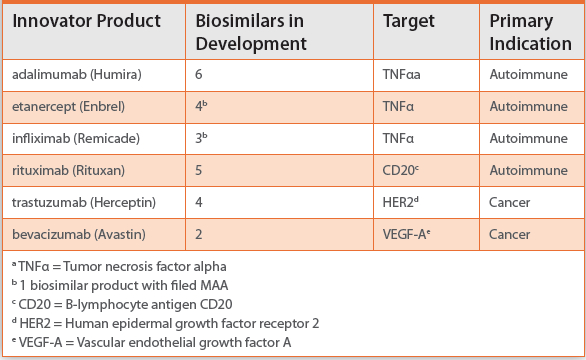The past thirty years have witnessed an impressive growth in sales of therapeutic monoclonal antibody (MAb) products. This growth of MAbs as a class of therapeutics was made possible in part by the development of large-scale mammalian cell culture, which enabled manufacturing of sufficient quantities of product to meet the market demands. The approval of Orthoclone OKT3 in 1986 for prevention of kidney transplant rejection was the first MAb approved for sale.1 In the intervening decades, many MAb products have been approved for commercial sale in the US, Europe, and globally. MAb products have become established therapies for multiple diseases including rheumatoid arthritis, cancer, asthma, and others. This review of the molecular targets and therapeutic indications for MAb products that are currently on the market or in late stage development is based on a dataset extracted from bioTRAK®, BioProcess Technology Consultants’ proprietary database which tracks human recombinant biopharmaceuticals approved for and being developed for the US and EU markets.2 As of July 1, 2015, the bioTRAK® database contains over 550 active biopharmaceutical products, including a dataset of 120 late stage and currently marketed monoclonal antibody products. This data set of antibody products consists of 47 currently marketed therapeutic MAb products, 11 products with a filed BLA (Biologics License Application) for US market approval and/or a filed MAA (Marketing Authorization Application) for EU approval, as well as 62 products in Phase 3 development.
For this article, we define therapeutic MAb products as whole MAbs, antibody-drug conjugates, fragments, and antibody fusion proteins produced in mammalian cell culture. Diagnostic products, and antibodies and fragments produced in microbial systems are not included within this dataset since they form a very small percentage of the overall market. The 47 currently marketed MAb products produced using mammalian cell culture include seven antibody-protein fusion products, three antibody-drug conjugates, one fragment, and 36 full length MAb products including two biosimilar antibodies approved in the EU.
US/EU Approved MAb Therapeutics
The year of first approval in the US or EU for each of the 47 currently marketed MAb products is shown in Figure 1, beginning with abciximab (ReoPro) approved in 1994. Products previously approved but subsequently withdrawn from the market, such as Orthoclone OKT3, are not included in Figure 1. The early pattern of MAb product marketing approvals was uneven; however, since 2009 there have been two or more approvals each year. In the current year, as of July 1, 2015, there have been two approvals for new MAb products and there are 11 BLA and /or MAA applications currently being reviewed by the US and/or EU regulatory authorities.
 Figure 1. Annual Approvals for MAb Products Currently Marketed in US/EU.
Figure 1. Annual Approvals for MAb Products Currently Marketed in US/EU.For this analysis, the 47 approved MAb products have been assigned to one of six indication areas as shown in Table 1. While some antibodies are marketed for more than one indication area, the indication area of first approval is shown. Autoimmune disorders and cancer indications comprise the two largest areas of focus for currently marketed MAb products, comprising over 85% of currently marketed products in this dataset.
Table 1. MAb Therapeutics by Indication Area

Products in Development
As of July 1, 2015, there are 11 new MAb products under regulatory review for market approval. Two of these new products have BLA applications filed only, while seven have both BLA and MAA applications pending. In addition, there are two biosimilars that have MAA applications under review, one a biosimilar to etanercept (Enbrel) and the other a biosimilar to infliximab (Remicade).
In addition to the 11 products under review, there are 62 MAb products in Phase 3 development. The distribution of all these products by indication area is shown in Table 1. Autoimmune diseases and cancer continue to be the two indication areas receiving the most development attention; however, the distribution of indication areas is broadening. Approximately 25% of the MAbs in Phase 3 are to treat indications outside the autoimmune disease and cancer fields, including cardiovascular, neurological, and orthopedic indications, for which no MAb products are currently approved.
As the data in Table 1 indicate, in addition to the two biosimilar products seeking market approval, there are 22 biosimilars in Phase 3 development for the US and EU markets. A summary of the biosimilar development activity is shown in Table 2, together with the targets and indication areas for these MAb therapeutics.
Table 2. Summary of Late Stage Biosimilar Development Activity

Molecular Targets for MAb Products
The molecular targets for MAb products must generally be extracellular to be accessible to circulating therapeutic antibodies. These can include cell surface receptors, ligands such as growth factors, other cell surface or soluble targets, and viral or bacterial antigens. The molecular target categories and therapeutic indications for marketed MAb products and products in late-stage (BLA/MAA and Phase 3) development are shown in Tables 3 and 4. To review the targets and indications for products in late-stage development, the 24 biosimilar products were excluded, leaving 45 marketed products and 49 products in development in the dataset subset that was analyzed.
Table 3. Target Types by Therapeutic Area for Innovator Marketed MAb Products

Table 4. Target Types by Therapeutic Area for Innovator MAb Products in Development

Although many of the target types are consistent between the marketed and development products, two new indication categories are noted in the development products (cardiovascular and neurological), and some differences in target type are apparent within the development products that have begun to appear. For example, antigen targets increases from 20% to 35% and cell surface antigens went from 13% to 14%.
Cytokine binding by MAb therapeutics is a prominent target category in autoimmune diseases, whereas receptor binding in cancer therapies is favored. The broadening of targets across indication categories suggests that new strategies are being considered. This activity is seen in product development for allergy indications where cytokine and receptor targets are under investigation, not antigens.
Targets for Mab Products in Development
Among the MAb products in development, 34 interact with molecular targets not currently addressed by the marketed products. Of these, 21 involve targets for new therapeutic indications, and 13 are novel targets for indications addressed by marketed products. Table 5 is a summary of the target-indication results.
Table 5. Targets for MAb Products in Late Stage Development

In the new indication category are products in development for treating familial hypercholesterolemia, an indication that does not have a currently approved MAb therapy. These hypercholesterolemia products target proprotein convertase subtilisin/kexin type 9 (PCSK-9), a protein that controls the number of low-density lipoprotein receptors on the surface of liver cells. Reducing PCSK-9, increases the number of low-density lipoprotein receptors and improves LDL cholesterol elimination.3 Praluent (alirocumab) was given US market approval on July 24, 2015, while on June 10, 2015 the FDA’s Endocrinologic and Metabolic Drugs Advisory Committee recommended approval of Repatha (evolocumab) which the European Medicines Agency has also recommended for approval in Europe4,5,6. Table 6 provides a summary of these development programs.
Table 6. MAb Products for Treating Hypercholesterolemia Targeting PCSK-9

Interleukin cytokines and receptors have been successful targets for MAb therapeutics. GlaxoSmithKline has filed BLA and MAA applications for its product mepolizumab that targets the IL-5 cytokine molecule. The Pulmonary Allergy Drugs Advisory Committee of the FDA recommended the approval of mepolizumab for severe asthma with eosinophilic inflammation on June 11, 2015.7 IL-5 is one of several interleukin cytokine targets not associated with a current marketed product. The interleukin cytokines and receptors as targets offer many additional opportunities for MAb therapy development and may lead to antibodies with efficacy in multiple indications. For example, IL-6, the target of siltuximab, which is approved for Castleman’s disease, is currently being evaluated as a treatment target for rheumatoid arthritis by the Phase 3 MAb sirukumab.8 Another more recent molecular target for MAb development is Programmed cell death protein 1 receptor (PD-1), the target for two marketed cancer MAb therapies. Additionally, two MAb products are in development, also for cancer indications, that target the ligand for the PD-1 receptor, PD-L1.
As Table 5 indicates, a number of development programs are underway for indications already addressed by marketed MAb therapeutics. Asthma and non-small cell lung cancer lead this list. Two indications not in Table 5 are breast and colorectal cancer, yet these indications are the focus of late and early-stage biosimilar activity9,10.
Conclusion
MAbs as therapeutic agents continue to be seen as an advantageous platform for new drug development. As the biopharmaceutical industry continues to grow, the number of molecular targets and therapeutic indications that can be treated with MAb products will undoubtedly increase. Many products that are currently in late stage development are focused on novel targets, confirming that the number of indications that will be treated successfully with MAb therapeutics in the future will be larger than today. In addition to antibodies in development against novel targets, several late stage development programs focus on developing improved antibody products against known molecular targets and these programs may yield “biobetters” for indications such as asthma, leukemia, non-small cell lung cancer, and multiple sclerosis. The result of both of these important trends – growth in indication areas treated by MAbs and growth of biosimilars – is likely to be an increase in the demand for manufacturing capacity to produce monoclonal antibodies. The bioTRAK® database is designed to track trends in supply and demand for biopharmaceutical manufacturing capacity, and this database shows capacity utilization tightening over the coming five year period due in large part to these important trends.
References
- Pharma&MedTech Business Intelligence. Ortho gets first FDA okay for therapeutic monoclonal: Orthoclone OKT3 approved for renal transplants, target population 4,000 per year. Available at: https://www.pharmamedtechbi.com/publications/the-pink-sheet/48/025/ortho-gets-first-fda-okay-for-therapeutic-monoclonal-orthoclone-okt3-approved-for-renal-transplants?p=1
- Bioprocess Technology Consultants Inc. [Internet]. Woburn (MA): Bioprocess Technology Consultants, Inc. bioTRAK® database. Available at: http://www.bptc.com/pipeline-databases.php. Accessed July 26, 2015.
- National Library of Medicine, Genetics Home Reference PCSK9. Available at: http://ghr.nlm.nih.gov/gene/PCSK9. Accessed July 26, 2015.
- Drugs@FDA. Praluent approval. Available at: http://www.accessdata.fda.gov/scripts/cder/drugsatfda/index.cfm?fuseaction=Search.DrugDetails. Accessed July 29, 2015.
- Medscape.com Approve PCSK9 inhibitor evolocumab, FDA panel recommends. Available at: http://www.medscape.com/viewarticle/846236. Accessed July 28, 2015.
- European Medicines Agency. First-in-class treatment to lower cholesterol. Available at: http://www.ema.europa.eu/ema/index.jsp?curl=pages/news_and_events/news/2015/05/news_detail_002336.jsp&mid=WC0b01ac058004d5c1. Accessed July 30, 2015.
- GlaxoSmithKline, plc. GSK announces outcome of US FDA Advisory Committee recommending approval of mepolizumab for the treatment of adults with severe asthma. Available at: https://www.gsk.com/en-gb/media/press-releases/2015/gsk-announces-outcome-of-us-fda-advisory-committee-recommending-approval-of-mepolizumab-for-the-treatment-of-adults-with-severe-asthma/ Accessed July 24, 2015.
- Johnson & Johnson Services, Inc. Janssen announces initiation of phase 3 development program for sirukumab in rheumatoid arthritis. Available at: https://www.jnj.com/news/all/janssen-announces-initiation-of-phase-3-development-program-for-sirukumab-in-rheumatoid-arthritis. Accessed July 29, 2015.
- Generics and Biosimilars Initiative Online. Biosimilars of trastuzumab. Available at: http://www.gabionline.net/Biosimilars/General/Biosimilars-of-trastuzumab. Accessed July 30, 2015.
- Generics and Biosimilars Initiative Online. Biosimilars of bevacizumab. Available at: http://www.gabionline.net/Biosimilars/General/Biosimilars-of-bevacizumab. Accessed July 30, 2015
Author Biographies
Alfred R. Doig, Jr, MS, Publications Manager at BioProcess Technology Consultants, has over 30 years’ business development experience in the life sciences industry. Prior to joining BPTC, he directed the publishing and editorial activities at Drug & Market Development Reports and Insight Pharma Reports. Mr. Doig holds M.S. degrees in Health Sciences and Biochemistry from Northeastern University and Biochemical Engineering from M.I.T.
Dawn M. Ecker, MS, Consultant with BioProcess Technology Consultants, has 20 years of experience in the biotechnology industry, ranging from drug discovery, in vitro and in vivo screening, in vivo model development, pharmacokinetics, and the manufacturing and purification of recombinant products and biopolymers. At Bioprocess Technology Consultants, she is responsible for maintaining the company’s bioTRAK® database. Ms.Ecker holds a B.S. in Microbiology/Biotechnology from Quinnipiac University and a M.S. in Biology from Worcester Polytechnic Institute.
Thomas C. Ransohoff , MS, Vice President and Principal Consultant at BioProcess Technology Consultants, is an expert in development and scale-up of biopharmaceutical processes; separations and purification technologies and cGMP manufacturing. Mr. Ransohoff is a cofounder of Tarpon Biosystems and BioFlash Partners. Mr. Ransohoff held senior positions at TranXenoGen, Dyax, Repligen, and Xoma. He holds a B.S. in Chemical Engineering from MIT and an M.S. in Chemical Engineering from the University of California, Berkeley.